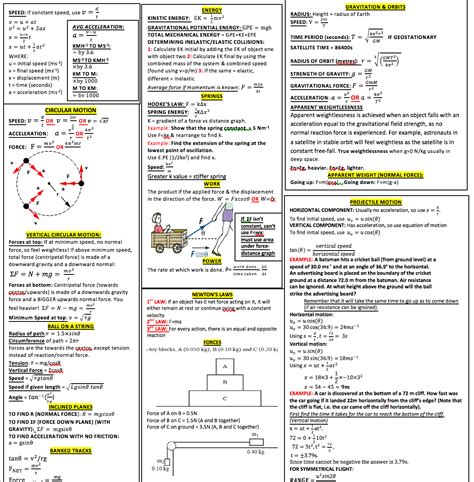Table of Contents
- Motion and Mechanics
- Energy and Work
- Waves and Optics
- Electricity and Magnetism
- Modern Physics
Motion and Mechanics
Newton’s Laws of Motion
- First Law: An object at rest stays at rest, and an object in motion stays in motion at a constant velocity, unless acted upon by an external force.
- Second Law: The acceleration of an object is directly proportional to the net force acting on it, and inversely proportional to its mass. (F = ma)
- Third Law: For every action, there is an equal and opposite reaction.
Kinematics
- Displacement: The change in position of an object.
- Velocity: The rate of change of displacement.
- Acceleration: The rate of change of velocity.
Dynamics
- Momentum: The product of an object’s mass and velocity. (p = mv)
- Kinetic Energy: The energy of an object due to its motion. (Ek = 1/2 mv^2)
- Gravitational Potential Energy: The energy of an object due to its position in a gravitational field. (Ep = mgh)
Energy and Work
Energy Conservation
- Energy cannot be created or destroyed, only transformed from one form to another.
Types of Energy
- Kinetic Energy: Energy of motion. (Ek = 1/2 mv^2)
- Potential Energy: Energy stored due to position or configuration.
- Thermal Energy: Energy due to the random motion of particles.
- Electrical Energy: Energy associated with electric charges.
- Magnetic Energy: Energy associated with magnetic fields.
Work
- Work is done when a force moves an object through a distance.
- Power is the rate at which work is done. (P = W/t)
Waves and Optics
Types of Waves
- Mechanical Waves: Require a medium to propagate.
- Electromagnetic Waves: Do not require a medium, can travel through vacuum.
Properties of Waves
- Wavelength: The distance between two consecutive crests or troughs.
- Frequency: The number of oscillations per second.
Reflection and Refraction
- Reflection: When a wave bounces off a surface.
- Refraction: When a wave changes direction when passing from one medium to another.
Electricity and Magnetism
Electric Fields
- Electric fields are created by electric charges.
- Electric potential is a measure of the electric field strength.
Magnetic Fields
- Magnetic fields are created by moving electric charges or permanent magnets.
- Magnetic flux density is a measure of the magnetic field strength.
Electromagnetic Induction
- When a magnetic field changes, it induces an electric field.
- When an electric field changes, it induces a magnetic field.
Modern Physics
Quantum Mechanics
- Describes the behavior of particles at the atomic and subatomic level.
- Energy is quantized, meaning it can only exist in discrete packets.
Relativity
- Describes the behavior of objects moving at high speeds or in strong gravitational fields.
- Time and space are not absolute, but relative to an observer’s frame of reference.
Useful Tables
Table 1: Physical Constants

| Constant | Value |
|---|---|
| Speed of light in a vacuum | 299,792,458 m/s |
| Planck constant | 6.62607015 x 10^-34 J s |
| Gravitational constant | 6.67408 x 10^-11 m^3 kg^-1 s^-2 |
| Permittivity of free space | 8.854187817 x 10^-12 F/m |
| Permeability of free space | 1.256637061 x 10^-6 H/m |
Table 2: Kinematic Equations
| Equation | Description |
|---|---|
| x = vt + 1/2 at^2 | Displacement as a function of velocity and acceleration |
| v = u + at | Velocity as a function of initial velocity and acceleration |
| a = (v – u) / t | Acceleration as a function of final velocity, initial velocity, and time |
Table 3: Energy Equations
| Equation | Description |
|---|---|
| Ek = 1/2 mv^2 | Kinetic energy as a function of mass and velocity |
| Ep = mgh | Gravitational potential energy as a function of mass, gravity, and height |
| W = Fd | Work as a function of force and displacement |
Table 4: Electromagnetic Equations
| Equation | Description |
|---|---|
| E = qV / d | Electric field strength as a function of charge and distance |
| V = IR | Voltage as a function of current and resistance |
| B = μ0 I / (2πr) | Magnetic field strength as a function of current and distance |
Effective Strategies
Study Regularly
- Reviewing material consistently helps reinforce concepts and improves retention.
- Break down large topics into smaller, manageable chunks for better understanding.
Use Visual Aids
- Diagrams, graphs, and animations can help visualize complex concepts and make them more understandable.
- Create your own diagrams and equations to help organize information.
Practice Problem-Solving
- Solving problems strengthens your grasp of formulas and physics principles.
- Start with simpler problems and gradually increase difficulty as you progress.
Seek Help When Needed
- Don’t be afraid to ask for clarification from teachers, tutors, or classmates.
- Attending office hours or review sessions can provide additional support.
Common Mistakes to Avoid
Forgetting Units
- Always include appropriate units when solving problems and expressing results.
- Misusing units can lead to incorrect answers.
Mixing Up Equations
- Double-check which equations you’re using and ensure they’re applicable to the specific problem.
- Mismatched equations can result in nonsensical results.
Ignoring Negative Signs
- Pay attention to negative signs in equations, as they can significantly affect your answers.
- Overlooking negative signs can lead to errors in calculations.
Using Wrong Constants
- Utilize updated values for physical constants like the speed of light and gravitational constant.
- Using outdated or incorrect constants can result in inaccurate calculations.
Why Physics Matters
Physics is fundamental to understanding the world around us. It’s the study of the laws that govern the universe, from the motion of celestial bodies to the behavior of subatomic particles. Physics also has countless applications in various fields, including:
- Engineering: Designing efficient structures, developing new technologies, and improving existing systems.
- Medicine: Advancing medical imaging, developing treatments, and understanding the workings of the human body.
- Energy and Environment: Developing sustainable energy sources, combating climate change, and managing environmental resources.
- Transportation: Improving vehicle design, optimizing fuel efficiency, and enhancing safety features.
Benefits of Physics
Studying physics offers several benefits, including:
- Critical Thinking and Problem-Solving: Physics trains you to analyze complex problems, identify patterns, and develop logical solutions.
- Quantitative Reasoning: Physics relies heavily on mathematics, fostering skills in numerical analysis, data interpretation, and quantitative reasoning.
- Communication Skills: Communicating physics concepts effectively requires clear and concise writing and speaking skills.
- Creativity and Innovation: Physics inspires creative thinking and innovation by encouraging students to explore unanswered questions and push the boundaries of knowledge.
